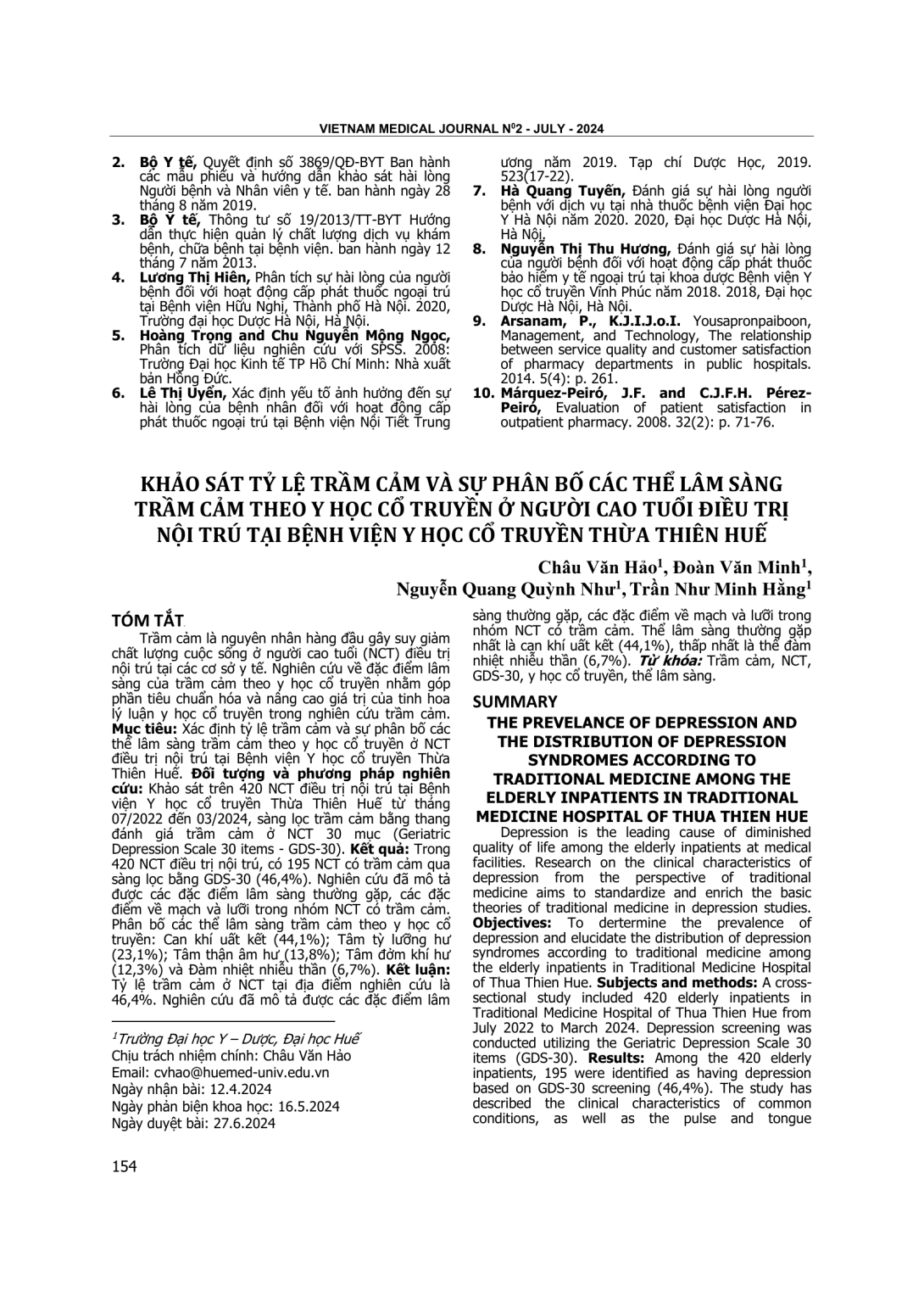
Xác định tỷ lệ trầm cảm và sự phân bố các thể lâm sàng trầm cảm theo y học cổ truyền ở NCT điều trị nội trú tại Bệnh viện Y học cổ truyền Thừa Thiên Huế. Đối tượng và phương pháp nghiên cứu: Khảo sát trên 420 NCT điều trị nội trú tại Bệnh viện Y học cổ truyền Thừa Thiên Huế từ tháng 07/2022 đến 03/2024, sàng lọc trầm cảm bằng thang đánh giá trầm cảm ở NCT 30 mục (Geriatric Depression Scale 30 items - GDS-30). Kết quả: Trong 420 NCT điều trị nội trú, có 195 NCT có trầm cảm qua sàng lọc bằng GDS-30 (46,4%). Nghiên cứu đã mô tả được các đặc điểm lâm sàng thường gặp, các đặc điểm về mạch và lưỡi trong nhóm NCT có trầm cảm. Phân bố các thể lâm sàng trầm cảm theo y học cổ truyền: Can khí uất kết (44,1%); Tâm tỳ lưỡng hư (23,1%); Tâm thận âm hư (13,8%); Tâm đởm khí hư (12,3%) và Đàm nhiệt nhiễu thần (6,7%). Kết luận: Tỷ lệ trầm cảm ở NCT tại địa điểm nghiên cứu là 46,4%. Nghiên cứu đã mô tả được các đặc điểm lâm sàng thường gặp, các đặc điểm về mạch và lưỡi trong nhóm NCT có trầm cảm. Thể lâm sàng thường gặp nhất là can khí uất kết (44,1%), thấp nhất là thể đàm nhiệt nhiễu thần (6,7%).
To dertermine the prevalence of depression and elucidate the distribution of depression syndromes according to traditional medicine among the elderly inpatients in Traditional Medicine Hospital of Thua Thien Hue. Subjects and methods: A cross-sectional study included 420 elderly inpatients in Traditional Medicine Hospital of Thua Thien Hue from July 2022 to March 2024. Depression screening was conducted utilizing the Geriatric Depression Scale 30 items (GDS-30). Results: Among the 420 elderly inpatients, 195 were identified as having depression based on GDS-30 screening (46,4%). The study has described the clinical characteristics of common conditions, as well as the pulse and tongue characteristics observed in a group of elderly individuals with depression. The distribution of depression syndromes according to traditional medicine revealed: Liver qi stagnation syndrome (44,1%); Heart and spleen deficiency syndrome (23,1%); Heart and kidney yin deficiency syndrome (13,8%); Heart and gallbladder qi deficiency syndrome (12,3%) and Phlegm heat harassing the mind syndrome (6,7%). Conclusions: The prevalence of depression among the elderly inpatients was 46,4%. The study has described the characteristics of common conditions according to traditional medicine, as well as the pulse and tongue characteristics observed in a group of elderly individuals with depression. The most prevalent syndrome observed was liver qi stagnation syndrome (44,1%), the lowest was phlegm heat harassing the mind syndrome (6,7%).
- Đăng nhập để gửi ý kiến
